
|
 |

|
 |
Kambaramayanam: a dance-drama in Bharatanatyam style Interview with Usha Raghavan - Dr. Elisa Ganser e-mail: elijanart@yahoo.it June 5, 2012 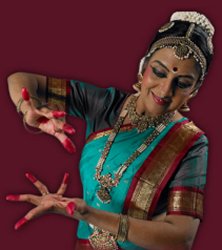 After the success of Maya's Dream, a dance-drama in Sanskrit on the birth of the Buddha, Usha Raghavan, Director of Kalasagara UK, comes back on the scene with a new production on the Ramayana. This Bharatanatyam version of the grand epic featuring 26 artists was presented on the 6th of April 2012 at the outskirts of Paris, Villebon-sur-Yvette, France. The festival 'Passeport pour l'Inde' organised by KaleidanScope has seen the Kambaramayanam - 12th century Tamil version of the original Sanskrit poem by Valmiki - come to life on the large stage of the Centre Culturel Jacques Brel, under the patronage of the Embassy of India. The London debut took place on the 29th of April, at the Bharatiya Vidya Bhavan centre. I had the pleasure to interview the dancer and choreographer Usha Raghavan about the artistic choices and ideas that have guided this production. Here are some excerpts from our dialogue. Usha, why did you choose to present Kamban's Ramayana instead of the more popular version of the epic by Valmiki? When I was invited to present a dance performance for the Festival 'Passeport pour l'Inde' in France, the organizer Milena Salvini was keen that I should present a dance-drama. Out of the several themes I proposed, she favoured Kambaramayanam, as Kamban's adaptation of the epic is not as well known in Europe as the one by Valmiki. 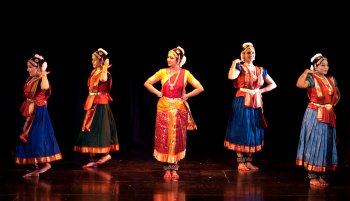 Sita with Sakis ; Photo: J Kumar Kambaramayanam is a vast piece of literature. How did you select the episodes you wanted to include in your production? What were the criteria guiding the choice of the relevant verses? Well, before we started working on it, I was told that the length of the performance should be of 90 minutes. From among the approximately 12,000 verses spread among the 6 chapters of the epic, I initially chose only a few verses that would at the same time bring out the beauty of the Ramayana in its entirety and suit the dance sequences throughout. Then I began to jot down what exactly I wanted to present and how the dance drama should flow, keeping in mind the mood and momentum required. Initially, I was carried away by the superb lyrics of Kamban. Every chapter and every verse was captivating. I therefore started shortlisting the verses that would best render the scenes I imagined based on emotional variety. I like scenes with alternating solo, duet, and group dances, in order to create a dramatic effect. I then visualized the different characters and how I wanted them to act and react in every scene. Also, I was very keen to present aspects that I found remarkably different from the more popular version of the Ramayana. I hence dwelt particularly on those verses that would match with the episodes and scenes as I had envisioned them. When I create a new work, I am always very careful to ensure that my choreographies are true to the authentic literary composition. Given this, I consulted Mr. S. Swaminathan, Tamil scholar and teacher at the School of Oriental and African Studies, London. After considerable deliberation he approved of my choice of episodes and verses. I too was, by then, convinced with my choice of verses and went ahead deciding the scenes based on them. All in all, the entire gamut of human emotions has been masterly explored through visual and musical devices, where the recurrence of determinate elements and the play of mirrors - for instance the simultaneous narration of the same episodes by Sita to Hanuman and by Rama to Lakshmana towards the end - build up ever refreshing suggestions worthy of the best tradition of Indian aesthetic theory. It was very interesting for connoisseurs and dancers to see how you dealt with some of the episodes different from Valmiki's version. Can you elaborate on those? As a matter of fact, some were chosen for the sheer joy of highlighting the attractiveness of Kamban's interpretation. For example, the scene of 'Sita Swayamvaram' wherein according to Kamban, King Janaka himself requests Rama to lift and string the bow. King Janaka is here portrayed as a father anxious to find a suitable groom for his daughter. 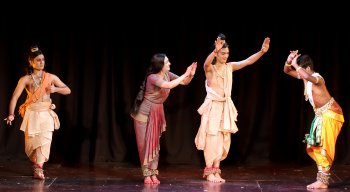 Rama, Sita, Lakshmana Bharata ; Photo: J Kumar 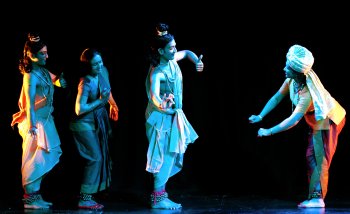 Rama, Sita, Lakshmana & Guhan on boat ; Photo: J Kumar Moreover, the Ramayana as we know it from Valmiki has Lakshmana getting angry and mutilating Surpanaka due to her unwarranted advances, whereas according to Kamban, Lakshmana gets angry only after Surpanaka tries to abduct helpless Sita. In Valmiki's Ramayana, Lakshmana draws a protective line (the so-called 'Lakshman rekha') around the hermitage as he goes in search of Rama upon Sita's insistence. In Kamban's version, Lakshmana requests Jatayu to take care of Sita and leaves in search of Rama. There is no mention of 'Lakshman rekha.' The most interesting couple of stanzas I wanted to present are found in Sundarakandam; these portray the meeting of Hanuman and Sita in Ashokavanam. Originally, I intended to narrate the story of Kakasuran, which is a popular story that Sita narrates to Hanuman on that occasion. But I eventually came across two brilliant verses. Sita requires Hanuman to go and tell Rama thus: "The day he held my hand in marriage, he promised me that he would never even think of another woman in this life. Please mention this to him." "Once when I asked what name I shall give my pet parrot, my beloved Rama, who is the embodiment of dharma, suggested that I give the name of his impeccable mother Kaikeyi." 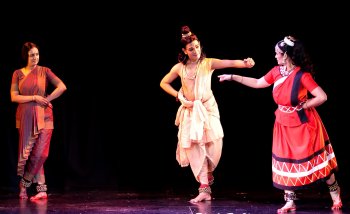 Rama, Sita & Surpanaka ; Photo: J Kumar 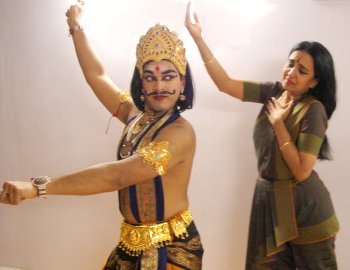 Sita & Ravana Adding to the richness of this performance, careful lighting and musical accompaniment serve as expressive means throughout the show. Two scenes in particular, enchained one after the other, were especially dramatic due to the effective rendering of their contrasting moods: Rama leaving Ayodhya at night, and the boat ride with Guhan the following dawn. How did you use lighting in this production? In the very beginning I had decided that we would not use any scene setting; nor would there be any prop. I wanted to convey everything through abhinaya and hastamudras. Hence I used special lighting only to recreate the effects of distance, space and height. In the scene where Sita sees Rama from the balcony, I used a beam of light aligning Rama and Sita diagonally from above to show the height. When Kaikeyi and Mantharai plot, the reaction of the citizens in the background was underlined through spotlights. In the scene mentioned before, about Sita in Lanka conveying to Hanuman some incidents from the past while Rama, far away in the forest, reminisces together with Lakshmana the same identical incidents, the distance between the two has been shown through variation and depth in lighting. This being a dance-drama, as a general rule, care was taken to highlight the emotions of every character through discreet lighting. In our talk following the performance you mentioned the significance of the choice of the various ragas and talas in the performance. What role did music composition play in the production process? Every verse was tuned keeping in mind the mood of the character and the scene. However, some scenes are particularly significant. For instance, Amritavarshini, a raga whose association with rain suggests the beginning of a new life, was chosen to proclaim Rama's coronation towards the beginning of the performance. The same tune in Amritavarshini is again repeated at the very end, suggesting that Rama's coronation can finally take place. 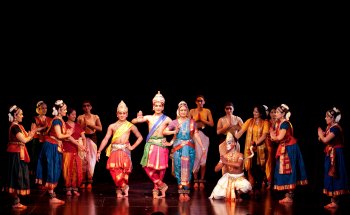 Pattabhishekam ; Photos: J Kumar 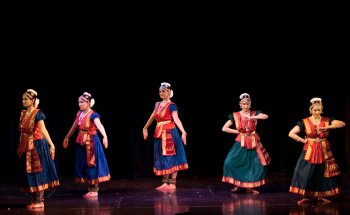 Celebrating Pattabhishekam ; Photos: J Kumar King Janaka's entry with his retinue set in majestic Gambiranattai, Sita's entry in Vasantha, dawn in the forest in Malayamarudham, Kaikeyi's anger in Hamsanandi and Surpanaka's advances towards Rama in Bilahari, to name a few, contributed to the enhancement of rasaanubhava. The choral battle scenes towards the end in chatusram, khandam and mishram were set in most suitable raga patterns building up for the decisive knock-down of Ravana. Starting from the opening scene, all the choreographic elements are tuned to a crescendo through music. I reckon that the music was set by Sudharshana Arunkumar in Los Angeles. How did she contribute to this production all the way from the west coast of the United States? Sudharshana is a Carnatic vocalist who is also a noted Bharatanatyam dancer, originally from Chennai, currently living in Los Angeles. She has already composed some of the music score for my previous works like 'Her Story.' I hence proposed her to work for this production too. As soon as I chose the verses, we both had a few brain storming meetings on skype. She then tuned the songs one by one based on my expectations and suggestions. Back and forth we worked throughout the production process, regardless of considerable time lag. Mutual understanding of the choreographic demands and meticulous work paid off well. The music score for this production has been receiving rave reviews. Everything considered, this performance looks like an ingeniously orchestrated piece. What sort of difficulties does a big production such as this one entail? The main problem was coordinating all 26 artists for rehearsals. I chose 13 of my senior students to perform all female roles and the roles of monkeys, Guhan and the soldiers. For the roles of Rama, Lakshmana, Hanuman and Ravana, I invited Santhosh Menon and other male dancers living in the UK. Working day and night for almost six months trying to match dancers and musicians according to time and space availability was a tremendous task. With many student-dancers living at least an hour or two away from my dance studio, it was not always possible to have everybody come together every time. I often had to write down / remember what I taught to one dancer, and then teach another one his or her part, keeping the exact sequence in mind. Deciding the roles as well as the sequence of entrance depending on the time required for the changes of costumes was a further challenge. Costumes had to be measured and tailored in Chennai. I had them made with 4 different tailors and couriered to London. Kambaramayanam was presented later in London. How was it received by the audience there? I am extremely satisfied with the success of the London show too. The most striking difference between the show in Paris and the one in London is that in Paris it was 99% French audience. Out of the nearly 450 people in the audience, many were at best aware of Ramayana as an epic in Indian lore, though there were connoisseurs too. In London, there is a lot of interest in Tamil culture, classical music and Ramayana. The sold out show in London had 70% Indians and Srilankan Tamils who are very well versed in the Ramayana and who are a lot more familiar not just with the story but also with the language, the idiom, the culture, etc. What excites me is the fact that in both shows people were extremely appreciative of the performance in every aspect, as their comments and feedback reveal. The earlier performances you have produced in London, Her Story, Navarasa, and Nivedanam were all sold out. So was it with Kambaramayanam. Is it just because of "home court advantage"? Contrary to belief, there is huge interest for traditional, classical arts among the Indian and Srilankan community here in the UK. When I do a choreographic work or produce a show, I always keep in mind the interest of the audience. In the first place, I choose a theme or a concept that would absolutely fascinate me. However, I must also be convinced that my audience will be able to enjoy not only the theme, but each and every aspect of the show along with me. I then do extensive preliminary work to be authentic in whatever I present. I work on the meaning and music before starting the choreographic work. On the day of the performance, care is taken to present the show with absolute professionalism. Starting and finishing the show as scheduled is imperative. I give a brief introduction before every performance in addition to a written synopsis. This enables even the uninitiated to enjoy the show. It takes years of sustained efforts to be recognised for professionalism in work. Once that is established, people just look forward to coming back again. Contact: u_raghavan@yahoo.com Dr. Elisa Ganser is a post-doctoral fellow at Ecole Pratique des Hautes Etudes, Paris. Her doctoral thesis in Asian Studies, discussed at the University of Rome "La Sapienza", focused on dance and aesthetics theory in the fourth chapter of Abhinavagupta's commentary on the Natyasastra. Besides her scholarly work, she has a practical knowledge of Indian dance.  Comments * Yet another wonderful production from Mrs. Usha Raghavan, 'Kambaramayanam' dance drama which was staged in two countries (France and England) was a delight to watch and a treat to all Bharatanatyam lovers. As a mother to a student of Usha Raghavan and a disciple, such performances are an inspiration to my daughter and me. Thank you. - J Ahilan (July 5, 2012) Post your comments Please provide your name and email id when you use the Anonymous/blog profile to post a comment. All appropriate comments posted with name & email id in the blog will also be featured in the site. |